What are the symptoms of downy mildew on leaves?
Downy mildew (Plasmopara viticola) develops on all the herbaceous organs, particularly those that are actively growing (rich in water). Downy mildew causes "oil spots" that are often observed on young leaves, and are characterized by the appearance of discoloured, yellow, oily-like patches on the upper surface, followed by the formation of fairly dense white down on the underside consisting of conidiophores and conidia. The damaged tissue turns brown and dries out. The mosaic appearance of mildew is usually observed at the end of the season on older leaves. Downy mildew outbreaks are manifested by numerous small yellow to reddish-brown polyhedral spots, bordered by the veins.
Extract from Vigne Vin Occitanie






